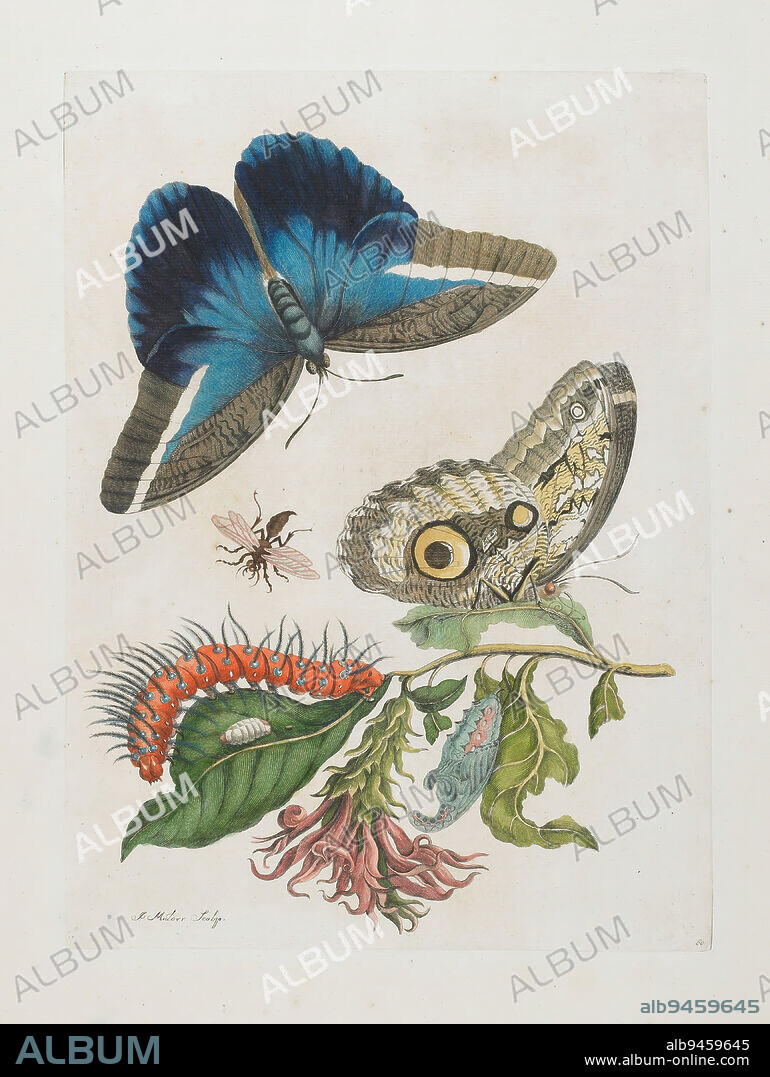alb9459645
Blue Butterflies and Red Larva, Blue Spines, c. 1705-1717, After Maria Sibylla Merian; Engraver: Joseph Mulder, German, 1647-1717, 13 x 9 5/8 in. (33.02 x 24.45 cm) (sheet), Hand-colored etching and engraving, Netherlands, 18th century, In January 1701 Merian wrote, 'I set out into the forest to see if I could discover anything; I found this elegant red blossom on a tree; neither the name nor the properties of this tree are known to the inhabitants of this country.' The butterfly is Caligo idomeneus (Linneaus), called an Owl Butterfly, because the large eye-spots on the undersides of the wings resembles the head of an owl when the wings are open. The larva illustrated is not that of an owl butterfly, but an unidentified species of silk moth. Merian also included a wasp, noting that wasps 'are found everywhere in Suriname, even in the houses and in the fieldsThey sting any man or animal which comes near them and disturbs their activities.'.

|
Ajouter à une autre Lightbox |
|
Ajouter à une autre Lightbox |



Avez-vous déjà un compte? S'identifier
Vous n'avez pas de compte ? S'inscrire
Acheter cette image.
Sélectionnez l'usage:

Légende:
Voir la traduction automatique
Blue Butterflies and Red Larva, Blue Spines, c. 1705-1717, After Maria Sibylla Merian; Engraver: Joseph Mulder, German, 1647-1717, 13 x 9 5/8 in. (33.02 x 24.45 cm) (sheet), Hand-colored etching and engraving, Netherlands, 18th century, In January 1701 Merian wrote, 'I set out into the forest to see if I could discover anything; I found this elegant red blossom on a tree; neither the name nor the properties of this tree are known to the inhabitants of this country.' The butterfly is Caligo idomeneus (Linneaus), called an Owl Butterfly, because the large eye-spots on the undersides of the wings resembles the head of an owl when the wings are open. The larva illustrated is not that of an owl butterfly, but an unidentified species of silk moth. Merian also included a wasp, noting that wasps 'are found everywhere in Suriname, even in the houses and in the fieldsThey sting any man or animal which comes near them and disturbs their activities.'
Crédit:
Album / quintlox
Autorisations:
Modèle: Non - Propriété: Non
Questions sur les droits?
Questions sur les droits?
Taille de l'image:
3465 x 4606 px | 45.7 MB
Taille d'impression:
29.3 x 39.0 cm | 11.6 x 15.4 in (300 dpi)
Mots clés:
18 18E 18EME XVIII XVIIIE XVIIIEME SIECLE • 18E SIECLE • 18EME S • ALLEMAND • ALLEMANDE • ANIMAL • ANIMAL: PAPILLON • ANIMAUX • ARBRE • ARBRES • BOIS, FORET • CHOUETTE • CHOUETTES • CISELEUR • DIX-HUITIÈME SIÈCLE • FORET • FRAVURE • GRAVURE • GUEPE • HIBOU • INSECTE: PAPILLON • MAISON • MAISONS • OISEAU: CHOUETTE • PAPILLON • SURINAME • TETE (ANATOMIE) • TETE • XVIIIE SIECLE
 Pinterest
Pinterest Twitter
Twitter Facebook
Facebook Copier le lien
Copier le lien Email
Email
